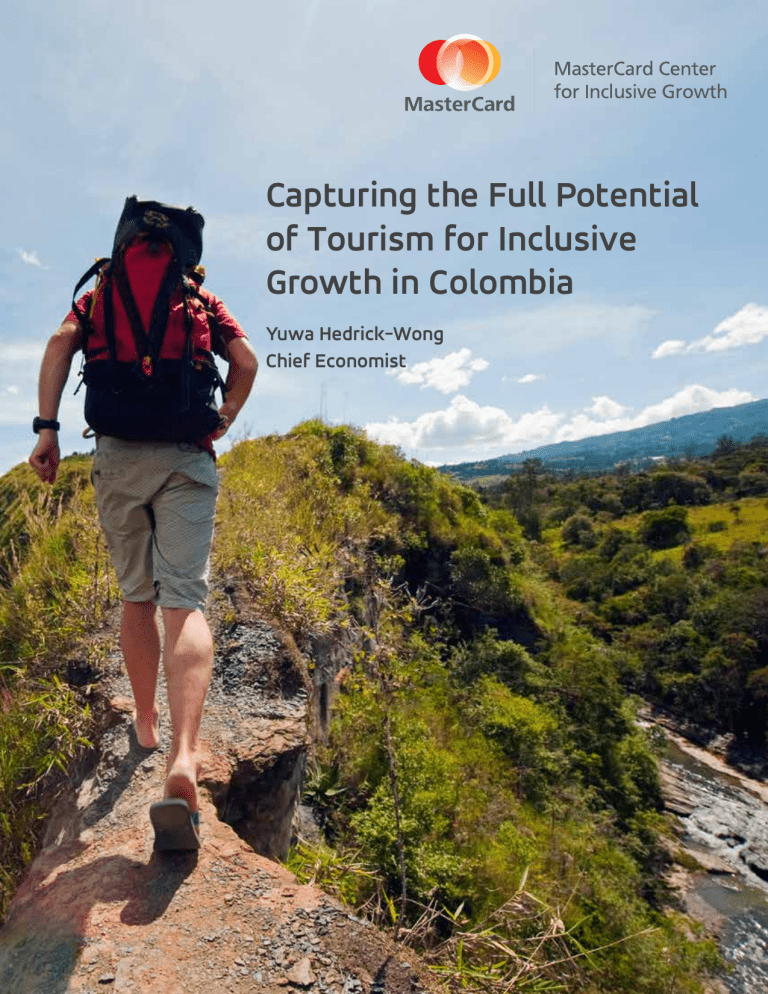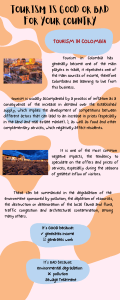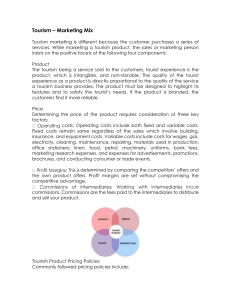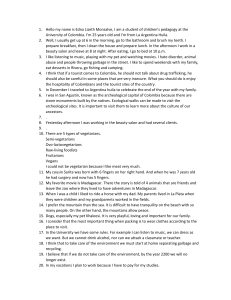
Capturing the Full Potential of Tourism for Inclusive Growth in Colombia Yuwa Hedrick-Wong Chief Economist 1 Executive Summary Tourism is an important sector for development in many countries. In leading tourist destination countries like the UK, Greece and Thailand, it accounts for between 3.7 to 9.3% of GDP. But the economic benefits of tourism are not always shared equally. Often, it is the big cities or those with the main tourist attractions that reap most, if not all, of the benefits. Policymakers interested in promoting tourism as a development strategy should consider ways to more equitably spread the benefits throughout the country. An analysis of foreign tourist spending conducted by Harvard’s Center for International Development reveals unique insights on the economic impacts of tourism. Researchers used anonymized and aggregated MasterCard transaction data to compare tourist spending in Colombia and the Netherlands. Key findings include: • The top five destinations in Colombia account for 81.1% of total foreign tourist spending in that country. In the Netherlands, the top five destinations account for only 39.2% of total foeign tourist spending. • More than half of foreign tourist card spend in Colombia is to obtain cash from ATMs, versus only 28% in the Netherlands. • Tourist spending on grocery stores, accommodations, and night clubs was much more geographically concentrated in Colombia than in the Netherlands. Tourists are more likely to spend money where making payments is convenient and secure. Enabling greater acceptance of electronic payments outside of the main urban areas and beyond larger merchants would increase the opportunity for inclusive growth. 2 Key findings Tourism is an important sector in Colombia. It accounts for some 6.1% of GDP in 2015, which puts Colombia in the mid-range of the leading tourist destination countries like Thailand, Greece and the UK, where tourism accounts for 9.3%, 7.6% and 3.7% of GDP respectively.1 How tourism affects inclusive growth depends on whether tourism revenues can spread beyond large travel and hospitality operators to benefit small local business and micro-entrepreneurs. So the first step in understanding better how tourism affects inclusive growth is to gain a deeper appreciation of the actual patterns of tourist spending once they have arrived in the destination country. Estimating the impacts of tourism on the domestic economy is very difficult. Because it is a form of exports that involves “importers,” the tourists, visiting the “exporting” country, a detailed understanding of the economic effects of tourism requires knowing where they go and how they spend. To generate new insights based on direct observations, researchers at the Center for International Development at Harvard University recently pioneered a whole new way of understanding the economic effects of tourism through the analysis of data made available by MasterCard for credit and debit card spending on foreign payment cards at merchants located in Colombia and the Netherlands (CID Tourism Study).2 A payment card is foreign when it is used in a country different from the one in which the bank issued the card. For this CID Tourism Study, MasterCard has made available to the CID research team anonymous and aggregated spend data on foreign credit and debit card payments based on merchant location in Colombia and the Netherlands over the period of October 2011 and September 2014. This allows the researchers to advance the frontier of research in unprecedented ways. It provides for the first time direct observations of tourists’ expenditures, effectively mapping foreign demand directly. Furthermore, the data set included the merchants’ addresses. Applying this information, the CID research team can then analyze such metadata to geolocate the expenditures, pinpointing where the expenditures take place; details that are not available from traditional research. The CID research team can also analyze the metadata of the merchants’ category codes to associate expenditures with merchant classification as well as their locations. 1 Data from World Travel and Tourism Council. 2 “Exploring Uncharted Exports: An Analysis of Tourism-Related Foreign Expenditures with International Card Data”, by Michele Coscia, Ricardo Hausmann, and Frank Neffke. April 2016. Working Draft, Center for International Development, Harvard University. Henceforth “CID Tourism Study” 3 There are three key aspects of the CID Tourism Study that are very relevant to a better understanding of how tourism affects inclusive growth: geography, payments and merchants. The key insights are summarized on the context of comparing Colombia with the Netherlands as follows. The Geographic Aspect The geographic aspect looks at where the tourists go in the destination country. Inclusive growth clearly benefits from a more dispersed geographical patterns of tourist activities. And the CID Tourism Study is able to illustrate precisely such differences between Colombia and the Netherlands. Chart 1 below provides the visual of the geographic distribution of tourist expenditures in Colombia. Assuming people are where they spend, tourists in Colombia concentrate around the big cities of Bogota, Medellin and Cali. They also are in big and well established resort centers like Cartagena. But much of the country is ignored by tourists. Chart 1. Most Popular Destinations in Colombia: Darkest color Corresponds to Highest US$ Expenditures, Lightest Color Corresponds to the Lowest US$ Expenditures; Top Six Tourist Destinations According to Trip Advisor. (Source: CID Tourism Study, Figure 2, P.4). #6 Santa Maria #1 Cartagena #3 Medellin #2 Bogota #5 Cali #4 Leticia 4 In contrast, Chart 2 is the visual of the geographic pattern of tourist spending in the Netherlands. Unlike Colombia, tourist spending is widely dispersed in the Netherlands. Assuming tourists are where they spend, virtually every municipality in the Netherlands has seen sizable foreign visitors. Chart 2. Most Popular Destinations in the Netherlands: Darkest color Corresponds to Highest US$ Expenditures, Lightest Color Corresponds to the Lowest US$ Expenditures; Top Six Tourist Destinations According to Trip Advisor. (Source: CID Tourism Study, Figure 3, P.5). #1 Amsterdam #4 Leiden #5 Utrecht #3 Rotterdam #2 The Hague #6 Roermond The contrasting visuals of Charts 1 and 2 are substantiated by the shares of tourist spending among the top destinations in Colombia and the Netherlands as summarized in Table 1. The top five destinations in Colombia account for 81.1% of total tourist spending. In comparison, the top five destinations in the Netherlands account for only 39.2% of the total. In fact, the CID Tourism Study estimates that the 75th percentile municipality in the Netherlands earned only 7 times tourist revenue as the 25th percentile municipality. In Colombia, however, the tourist revenue earned by the 75th percentile municipality is 57 times higher than the 25th percentile municipality. The overall picture is that Colombia has only a few centralized tourist destinations that have either very weak or non-existent links to the rest of the country; while the Netherlands resembles a highly decentralized complex system. As a result, foreign tourist spending in Colombia is unlikely to have much impact on small businesses and micro-entrepreneurs outside of the few centralized tourist destinations. 5 Table 1. Distribution of Visitors Spending in the Top Ten Destinations: Colombia and the Netherlands (Source: CID Tourism Study, Tables 1 and 2) Colombia Rank Destinations Share of Total Tourist Spending 1 Bogota 39.0% 2 Cucuta 18.2% 3 Cartagena 9.6% 4 Medellin 8.3% 5 Cali 6.0% 6 Barranquila 2.5% 7 San Andres 1.8% 8 Santa Marta 1.5% 9 Pereira 1.2% 10 Envigado 0.8% The Netherlands Destinations Share of Total Tourist Spending Amsterdam 18.8% Roermond 6.6% Maastricht 5.7% Haarlemmermeer 4.7% Venlo 3.4% Amstelveen 2.6% Heerlen 2.5% Sluis 2.4% Breda 2.4% Rotterdam 2.2% The Payments Aspect How foreign tourists pay could also affect how the economic benefits of their spending are shared. Since card payments are the easiest, simplest and safest way to pay for foreign tourists, when acceptance of card payments is limited to large establishments and merchants in big cities and up-market resorts operated by global companies, then the majority of local small businesses and micro-entrepreneurs are effectively missing sales opportunities because they lack the ability to accept card payments. One finding from the CID Tourism Study reveals the differences in card payment acceptance between Colombia and the Netherlands. As Table 2 shows, it turns out that more than half of foreign tourists’ card spend in Colombia is in getting cash at ATMs, versus only 28% in the Netherlands. This clearly reflects much more limited acceptance of card payments in Colombia compared with the Netherlands, with the undesirable consequences that local small businesses and micro-entrepreneurs in Colombia are less able to share the economic benefits of foreign tourists spending than their counterparts in the Netherlands. Table 2. ATM Cash Withdrawal as Percentage of Total Card Spend by Tourists (Source: CID Tourism Study, Tables 7 and 8) Spend ATM Withdrawal as % of Total Card Usage 6 Colombia 53.4% The Netherlands 28.0% The Merchants Aspect The more small businesses are involved the more inclusive the economic benefits of tourism. The bigger merchants, including large national and even global retails chains, tend to locate themselves in large cities and bigger centers because they operate on large economies of scale. Smaller retail operators and microentrepreneurs, on the other hand, are scattered across the country. So if the distribution of spending in any merchant category is found to be highly dispersed across the country, then it is reasonable to conclude that more small businesses within a given merchant type are able to benefit from foreign tourist spending. The CID Tourism Study provides a visual comparison of the geographical dispersion of foreign tourist spending between Colombia and the Netherlands in three merchant categories: grocery stores, accommodation, and night clubs. This is shown in Chart 3. Consistent with the visuals of dispersion of tourist spend captured in Charts 1 and 2 above, tourist spending in these three merchant types is much more widely distributed in the Netherlands than in Colombia, suggesting that more small businesses are more likely to benefit from tourism in the Netherlands than in Colombia. Chart 3. Sector-Specific Maps for Colombia (Top) and the Netherlands (Bottom). From Left to Right: Grocery Stores, Accommodation, Night Clubs. (Source: CID Tourism Study, Figure 7, P.10). 7 The CID Tourism Study, in utilizing the unique data made available by MasterCard, advances the research frontier in understanding the economic impacts of tourism. In so doing, it also sheds new light on how tourism may affect inclusive growth in terms of three aspects of geography, payments and merchants. Tourism is an unusual form of export; it depends on buyers of the export coming to where the export is produced (tourist destinations) to pay for and enjoy it. In other words, the buyers (tourists) are the ones that are mobile, and the suppliers are relatively fixed in where they supply their products and services. In this context, the difference between large and small merchants is instructive. Large merchants, including national and global retail and hotel chains, are actually relatively “mobile”. They do their market research before choosing where to locate their operations. Once the locations are chosen, they also have the means to market them, attracting and convincing tourists to come to where they are. In contrast, small businesses and micro-entrepreneurs are truly “immobile.” They tend to operate near where they live and lack the means to conduct marketing campaigns to persuade tourists to come visit them. For tourism to be an effective driver of inclusive growth, foreign visitors should travel far and wide in the host country, engaging in the broadest range of activities that involve local small businesses and microentrepreneurs. In this regard, this comparison shows that Colombia has lagged behind the Netherlands in capturing the full potential of tourism in advancing inclusive growth. As Colombia’s decades-long insurgency conflict winds down and peace returns to areas previously made dangerous and unstable by the conflict, this is the time to encourage more tourist visits to all parts of the country, thereby supporting more inclusive growth in Colombia. 8 Contact: CNTR4growth@mastercard.com About Us The mission of the MasterCard Center for Inclusive Growth is to advance equitable and sustainable economic growth and financial inclusion around the world. As an independent subsidiary of MasterCard, we combine data, expertise, technology and philanthropic investments to empower a community of thinkers, leaders and innovators working on the front lines of inclusive growth. Join Our Community mastercardcenter.org @CNTR4growth MasterCard Center for Inclusive Growth






